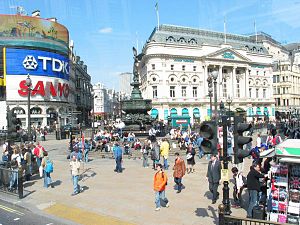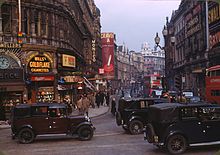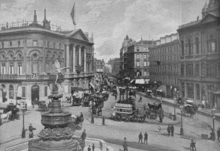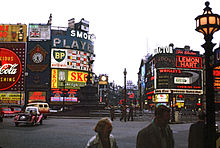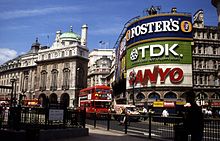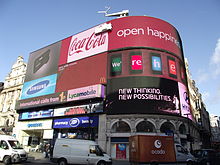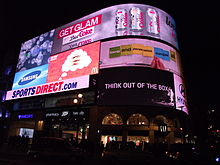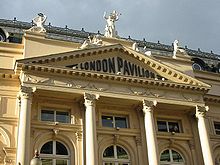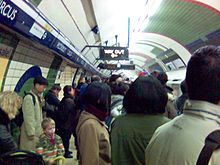
Piccadilly Circus
About this schools Wikipedia selection
SOS Children, an education charity, organised this selection. To compare sponsorship charities this is the best sponsorship link.
Piccadilly Circus is a road junction and public space of London's West End in the City of Westminster, built in 1819 to connect Regent Street with the a lot of shopping street of Piccadilly. In this context, a circus, from the Latin word meaning "circle", is a round open space at a street junction. Coordinates: 51°30′36″N 0°8′4″W
Piccadilly now links directly to the theatres on Shaftesbury Avenue, as well as the Haymarket, Coventry Street (onwards to Leicester Square), and Glasshouse Street. The Circus is close to major shopping and entertainment areas in the West End. Its status as a major traffic intersection has made Piccadilly Circus a busy meeting place and a tourist attraction in its own right. The Circus is particularly known for its video display and neon signs mounted on the corner building on the northern side, as well as the Shaftesbury memorial fountain and statue of the Greek god Anteros (popularly mistaken for his brother Eros). It is surrounded by several noted buildings, including the London Pavilion and Criterion Theatre. Directly underneath the plaza is Piccadilly Circus tube station, part of the London Underground system.
History
Piccadilly Circus connects to Piccadilly, a thoroughfare whose name first appeared in 1626 as Piccadilly Hall, named after a house belonging to one Robert Baker, a tailor famous for selling piccadills, or piccadillies, a term used for various kinds of collars. The street was known as Portugal Street in 1692 in honour of Catherine of Braganza, the queen consort of King Charles II of England but was known as Piccadilly by 1743. Piccadilly Circus was created in 1819, at the junction with Regent Street, which was then being built under the planning of John Nash on the site of a house and garden belonging to a Lady Hutton. The circus lost its circular form in 1886 with the construction of Shaftesbury Avenue.
The junction has been a very busy traffic interchange since construction, as it lies at the centre of Theatreland and handles exit traffic from Piccadilly, which Charles Dickens, Jr. described in 1879: "Piccadilly, the great thoroughfare leading from the Haymarket and Regent-street westward to Hyde Park-corner, is the nearest approach to the Parisian boulevard of which London can boast."
The Piccadilly Circus tube station was opened 10 March 1906, on the Bakerloo Line, and on the Piccadilly Line in December of that year. In 1928, the station was extensively rebuilt to handle an increase in traffic.
The intersection's first electric advertisements appeared in 1910, and, from 1923, electric billboards were set up on the facade of the London Pavilion. Traffic lights were first installed on 3 August 1926, at the junction.
At the start of the 1960s, it was determined that the Circus needed to be redeveloped to allow for greater traffic flow. In 1962, Lord Holford presented a plan which would have created a "double-decker" Piccadilly Circus; the upper deck would have been an elevated pedestrian concourse linking the buildings around the perimeter of the Circus, with the lower deck being solely for traffic, most of the ground-level pedestrian areas having been removed to allow for greater vehicle flow. This concept was kept alive throughout the rest of the 1960s. A final scheme in 1972 proposed three octagonal towers (the highest 240 feet (73 m) tall) to replace the Trocadero, the Criterion and the "Monico" buildings. The plans were permanently rejected by Sir Keith Joseph and Ernest Marples; the key reason given was that Holford's scheme only allowed for a 20% increase in traffic, and the Government required 50%.
The Holford plan is referenced in the short-form documentary film "Goodbye, Piccadilly", produced by the Rank Organisation in 1967 as part of their Look at Life series when it was still seriously expected that Holford's recommendations would be acted upon. Piccadilly Circus has since escaped major redevelopment, apart from extensive ground-level pedestrianisation around its south side in the 1980s.
The Shaftesbury Memorial Fountain in Piccadilly Circus was erected in 1893 to commemorate the philanthropic works of Anthony Ashley Cooper, 7th Earl of Shaftesbury. During the Second World War, the statue atop the Shaftesbury Memorial Fountain was removed and was replaced by advertising hoardings. It was returned in 1948. When the Circus underwent reconstruction work in the late 1980s, the entire fountain was moved from the centre of the junction at the beginning of Shaftesbury Avenue to its present position at the southwestern corner.
In May 2012 the Statue of Anteros had a new bow string fitted after it was broken by a tourist
Location and sights
Piccadilly Circus is surrounded by several major tourist attractions, including the Shaftesbury Memorial, Criterion Theatre, London Pavilion and several major retail stores. Numerous nightclubs and bars are located in the area and neighbouring Soho, including the former Chinawhite club.
Illuminated signs
Piccadilly Circus used to be surrounded by illuminated advertising hoardings on buildings, starting in the early 1900s, but only one building now carries them, the one in the northwestern corner between Shaftesbury Avenue and Glasshouse Street. The site is unnamed (usually referred to as "Monico" after the Café Monico, which used to be on the site); its addresses are 44/48 Regent Street, 1/6 Sherwood Street, 17/22 Denman Street and 1/17 Shaftesbury Avenue, and it has been owned by property investor Land Securities Group since the 1970s.
The earliest signs used incandescent light bulbs; these were replaced with neon lights, as well as moving signs (there was a large Guinness clock at one time).The very first Neon sign was for the British meat extract Bovril. From December 1998, digital projectors were briefly used for the Coke sign, the first to be computerised, while the 2000s saw a gradual move to LED displays, completely replacing neon lamps by 2011. The number of signs has reduced over the years as the rental costs have increased.
As of 2012, the site has six illuminated advertising screens above three large retail units facing Piccadilly Circus on the north side, occupied by Boots, GAP and a mix of smaller retail, restaurant and office premises fronting the other streets. A Burger King located under the Samsung advert, which had been previously a Wimpy Bar until 1989, closed in early 2008 and was converted into a Barclays Bank.
Coca-Cola has had a sign at Piccadilly Circus since 1954. The current placed sign dates in its original form from September 2003, when the previous digital projector board and the site formerly occupied by Nescafé was replaced with a state-of-the-art LED video display that curves round with the building. Before Nescafé, a neon advertisement for Foster's occupied the spot from 1987 until 1999, and from 1978 to 1987 it was used by Philips Electronics. On 23 November 2007, the very first film was broadcast through the board. The screen also displays information about line closures and delays on the London Underground. Paul Atherton's film The Ballet of Change: Piccadilly Circus was allowed five minutes to show the first non-commercial film depicting the history of Piccadilly Circus and the lights. The former, for several months in 2002, replacing the Nescafé sign, was a sign featuring the quote "Imagine all the people living life in peace" by Beatle John Lennon. This was paid for by his widow Yoko Ono, who spent an estimated £150,000 to display an advert at this location.
Hyundai Motors sign is the newest of the six, launching on 29 September 2011. It replaced a sign for Sanyo which had occupied the space unchanged since around early 1988, the last to be run by traditional neon lights rather than Hyundai's computerised LED screen. Earlier Sanyo signs with older logos had occupied the position since 1978, although these were only half the size of the current space.
TDK added its sign in 1990, the space having been previously used by Schweppes (1920–61), BP (1961–7), Cinzano (1967–78), Fujifilm (1978–86) and Kodak (1986–90). The original neon sign remained almost unchanged for twenty years, although in 2001, the colour of the background lamps was changed from green to blue, and the words "Audio & Video Tape" and "Floppy Disks" under the TDK logo were removed. In 2010, the sign was replaced by an LED screen.
McDonald's added its sign in 1987, replacing one for BASF. The sign was changed from neon to LED in 2001. A bigger, brighter screen was installed in 2008.
Samsung added its sign in November 1994, the space having been previously occupied by Canon (1978–84) and Panasonic (1984–94). The sign was changed from neon to LED in summer 2005. The screen was upgraded and improved in autumn 2011.
Piccadilly Lite was added on 3 December 2007, underneath the Samsung and McDonald's signs. This is an LED screen that allows other companies to advertise for both short- and long-term leases, increasing the amount of advertising space but using the same screen for multiple brands. The space was previously occupied by JVC (1978–84), Carlsberg (1984–2003) and Budweiser (2003–7).
LG were added as of February 2007 on the roof of Coventry House, which diagonally faces Piccadilly Circus. Their sign is a large LED video advertising display for LGE, the British arm of the South Korean electronics group. The new display also incorporates a scrolling ticker of Sky News headlines. Before LG, Vodafone had a neon sign installed on that spot, which displayed both their logo and personal messages that could be submitted on a special website and displayed at a certain time and date.
On special occasions the lights are switched off, such as the deaths of Winston Churchill in 1965 and Diana, Princess of Wales in 1997. On 21 June 2007, they were switched off for one hour as part of the Lights Out London campaign.
Other companies and brands that had previously had signs on the site were Guinness, Max Factor, Wrigley's Spearmint, Skol, Air India and Gold Flake (as Will's Gold Flake Cigarettes).
Shaftesbury Memorial and the Statue of Anteros (Eros)
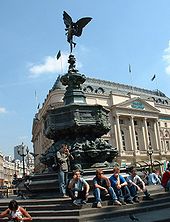
At the southwestern side of the Circus, moved after World War II from its original position in the centre, stands the Shaftesbury Monument Memorial Fountain, erected in 1892–1893 to commemorate the philanthropic works of Lord Shaftesbury, who was a famous Victorian politician and philanthropist.
The monument is topped by Alfred Gilbert's winged nude statue of the Greek god Anteros, sometimes referred to as The Angel of Christian Charity and popularly mistaken as his brother, Eros. The statue has become a London icon: a graphical illustration of it is used as the symbol of the Evening Standard newspaper and appears on its masthead.
The use of a nude figure on a public monument was controversial at the time of its construction, but it was generally well received by the public. The Magazine of Art described it as "...a striking contrast to the dull ugliness of the generality of our street sculpture, ... a work which, while beautifying one of our hitherto desolate open spaces, should do much towards the elevation of public taste in the direction of decorative sculpture, and serve freedom for the metropolis from any further additions of the old order of monumental monstrosities."
The statue was the first in the world to be cast in aluminium and is set on a bronze fountain, which itself inspired the marine motifs that Gilbert carved on the statue.
While the statue is generally believed to depict Eros, it was created as an image of his twin brother, Anteros. The sculptor Alfred Gilbert had already sculpted a statue of Anteros and, when commissioned for the Shaftesbury Memorial Fountain, chose to reproduce the same subject, who, as "The God of Selfless Love" was deemed to represent the philanthropic 7th Earl of Shaftesbury suitably. Gilbert described Anteros as portraying "reflective and mature love, as opposed to Eros or Cupid, the frivolous tyrant." The model for the sculpture was Gilbert's studio assistant, a 16-year-old Italian, Angelo Colarossi (born 1875).
Where Anteros originally pointed his bow is the subject of two urban myths. The first is that the archer is aiming up Shaftesbury Avenue. Sometimes, the story goes that this was a visual pun to commemorate the great philanthropist. If the archer were to release his arrow, its shaft would bury itself in Shaftesbury Avenue. The other is that the arrow is pointing to the Earl's country seat in Wimborne Saint Giles, Dorset. However, the 1896 photographs (on this page) of the circus taken only three years after the statue's erection clearly shows the arrow pointing in a different direction, down Lower Regent Street aptly towards Parliament. This is proven by the position relative to the statue of Shaftesbury Avenue, the London Pavilion and the Criterion Theatre.
When the memorial was unveiled, there were numerous complaints. Some felt it was sited in a vulgar part of town (the theatre district), and others felt that it was too sensual as a memorial for a famously sober and respectable Earl. Some of the objections were tempered by renaming the statue as The Angel of Christian Charity, which was the nearest approximation that could be invented in Christian terms for the role Anteros played in the Greek pantheon. However the name never became widely known and the statue became generally known as Eros, the god of sensual love; quite inappropriate to commemorate the Earl, but just right to signify the carnal neighbourhood of London, into which Soho had developed.
Criterion Theatre
The Criterion Theatre, a Grade II* listed building, stands on the south side of Piccadilly Circus. Apart from the box office area, the entire theatre, with nearly 600 seats, is underground and is reached by descending a tiled stairway. Columns are used to support both the dress circle and the upper circle, restricting the views of many of the seats inside.
The theatre was designed by Thomas Verity and opened as a theatre on 21 March 1874, although original plans were for it to become a concert hall. In 1883, it was forced to close to improve ventilation and to replace gaslights with electric lights and was reopened the following year. The theatre closed in 1989 and was extensively renovated, reopening in October 1992.
London Pavilion
On the northeastern side of Piccadilly Circus, on the corner between Shaftesbury Avenue and Coventry Street, is the London Pavilion. The first building bearing the name was built in 1859 and was a music hall. In 1885, Shaftesbury Avenue was built through the former site of the Pavilion, and a new London Pavilion was constructed, which also served as a music hall. In 1923, electric billboards were erected on the side of the building.
In 1934, the building underwent significant structural alteration and was converted into a cinema. In 1986, the building was rebuilt, preserving the 1885 facade, and converted into a shopping arcade. In 2000, the building was connected to the neighbouring Trocadero Centre, and signage on the building was altered in 2003 to read "London Trocadero". The basement of the building connects with Piccadilly Circus tube station.
Major shops
The former Swan & Edgar department store on the west side of the circus between Piccadilly and Regent Street was built in 1920–23 to a design by Reginald Blomfield. Since the closure of the department store in the early 1980s, the building has been successively the flagship London store of music chains Tower Records, Virgin Megastore and Zavvi. The current occupier is clothing brand The Sting.
Lillywhites is a major retailer of sporting goods located on the corner of the circus and Lower Regent Street, next to the Shaftesbury fountain. It moved to its present site in 1925. Lillywhites is popular with tourists, and they regularly offer sale items, including international football jerseys up to 90% off. Nearby Fortnum & Mason is often considered to be part of the Piccadilly Circus shopping area and is known for its expansive food hall.
Underground station and the Piccadilly Line
The Piccadilly Circus station on the London Underground is located directly beneath Piccadilly Circus itself, with entrances at every corner. It is one of the few stations which have no associated buildings above ground and is fully underground. It is itself a Grade 2 listed building.
The station is on the Piccadilly Line between Green Park and Leicester Square, and the Bakerloo Line between Charing Cross and Oxford Circus.
Metronet, until 2008 one of the two private maintenance companies for the London Underground under a public-private partnership arrangement, refurbished Piccadilly Circus station with work started in March 2005 and completed in spring 2007. Major improvements included new floor and wall finishes, a new CCTV system, new help points, a new public address system, new electronic information displays and clocks, improved platform seating, waterproofing measures, measures to assist visually impaired passengers and improved lighting. Moving stairs or escalators were also replaced.
In popular culture
The phrase it's like Piccadilly Circus is commonly used in the UK to refer to a place or situation which is extremely busy with people. It has been said that a person who stays long enough at Piccadilly Circus will eventually bump into everyone they know. Probably because of this connection, during World War II, "Piccadilly Circus" was the code name given to the Allies' D-Day invasion fleet's assembly location in the English Channel.
Piccadilly Circus has inspired artists and musicians. Piccadilly Circus (1912) is the name and subject of a painting by British artist Charles Ginner, part of the Tate Britain collection. Sculptor Paul McCarthy also has a 320-page two-volume edition of video stills by the name of Piccadilly Circus.
L. S. Lowry R.A painting 'Piccadilly Circus, London' (1960), part of Lord Charles Forte's collection for almost three decades, sold for £5,641,250 when auctioned for the first time at Christie's 20th Century British & Irish Art sale on 16 November 2011.
